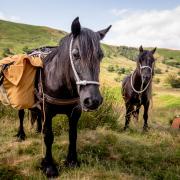Pictures taken by the world’s fastest photographer give a new view of Lancashire

Lancashire is blessed with landscapes that look impressive from most angles, but few people get to see the county from this perspective. These amazing shots were taken from a Typhoon jet which can travel at Mach 2 – that’s about 1500mph.
The Typhoon is built at the BAe Systems bases at Samlesbury near Preston and Warton on the Fylde coast where they are tested before being put into action with the RAF and other air forces around the world.
Lancashire’s Mark Bowman has been the chief test pilot at Warton since 2010. There are five other test pilots at Warton (and about half a dozen more are based around the country) and Mark, a former RAF fighter pilot, said Lancashire and the North West provide the perfect environment for testing jets.

‘Lancashire is very varied and it provides a unique place to test these aircraft,’ he said. ‘When you’re sitting at 55,000 feet, about four miles higher than an airliner, you get an amazing perspective of the patchwork of the county,’ he said.
‘It is very rare that you can sit back and take in the view, and with the speed the Typhoon travels there’s hardly time to see it anyway. The whole county may only take a few minutes to cross but you do get a real impression of the landscape.’
Mark, who was born in Urmston, used to spend his spare time and school lunch breaks cycling to Manchester Airport and Barton Aerodrome to watch the planes and decided at the age of 11 that he wanted to fly. To gain experience he did odd jobs at Barton, including painting the toilets, and was paid in flying time.

‘I decided that if someone else can do it, then so can I,’ he said. ‘I have always had a fascination with fast aircraft and my target was always to fly. I had a flying licence before I had a driving licence.’
He joined the RAF as a 17-year-old and served across the globe flying Harrier jets before joining BAe in 1998.
‘Technology has changed enormously since I started flying, almost beyond recognition. I don’t want to talk down the Harrier, it was a very capable aircraft, but there is no doubt that the Typhoon takes your breath away, you always get that thrill. It’s like a huge kick in the pants when you’re going down the runway. It’s very difficult to describe what it’s like to someone who hasn’t experienced it. It’s something totally out of the ordinary. It is such a privileged position.

‘There is a real heritage in the aircraft industry in this area. Lots of people are involved and have been involved in designing and building these aircraft. I’m just the lucky guy who gets to fly them.’
Those who live close to the areas where the test flights are conducted may not feel so lucky. The window-rattling scream of jet planes is an unavoidable consequence of the region’s important role in the industry and Mark, who now lives with his partner in the Ribble Valley, added: ‘We know the flights cause some noise and disturbance and we are all very appreciative of people’s understanding, tolerance and continuing support.
‘Most of the test flights are done over the sea and when we fly at supersonic speeds we do it over the sea to minimise disturbance but it doesn’t always work. There were reports once of an earthquake in Blackpool but it was just me flying supersonic out at sea.’

The pictures on these pages were taken by the world’s fastest photographer, Chris Ryding who dreamed of being a photographer when he was growing up in Tarleton. When he started at BAe almost 30 years ago he was one of 27 photographers but there are now just three and Chris, who lives at Southport, said: ‘I was taking pictures of anything and everything – it was a very good grounding.’
But he’s left the ground behind for these shots. ‘The primary role of aerial photographs is to gather test evidence and I’m fortunate that I have a stomach that can handle being turned upside down. It is disorientating when you’re travelling at such high speed but your eyes are fixed on another vehicle that is moving at the same speed so it looks still.
‘You can feel the g-forces though – they make your body and the camera feel heavy. And all the time the guy at the front is trying to separate you from your lunch. There probably are easier ways to make a living but it is good fun – I get to fly in the big boys’ toys and it is very exciting.’



























